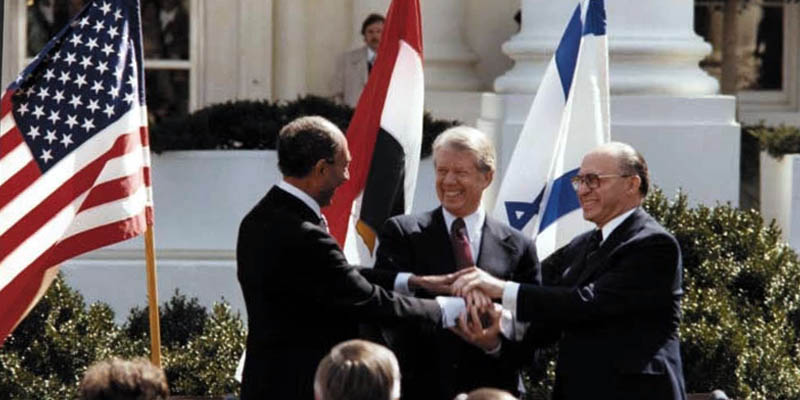We explain the causes of the conflict between Arabs and Jews over the creation of the State of Israel. In addition, we discuss the role of the UN.

What is the Arab-Israeli conflict?
The Arab-Israeli conflict is the name given to the confrontation between the Jewish nation State of Israel and neighboring Arab countries. The conflict has its roots in the dispute over Palestinian territory, which formerly belonged to the Ottoman Empire and later to the British Mandate of Palestine. Major Arab-Israeli military confrontations include the First Arab-Israeli War (1948-1949), the Six-Day War (1967), and the 1973 Arab-Israeli War.
During the second half of the 20th century, the conflict between Jews and Arabs affected the political relations of all Middle East countries. The origin of the conflict is linked to the emergence of political Zionism preached by Theodor Herzl in the late 19th century, the rise of Jewish and Arab nationalism, the emigration of the Jewish population from different parts of the world to Palestine, foreign intervention from the United Kingdom, and the influence of the United Nations.
- See also: World War II
Background of the Arab-Israeli conflict
Origin of political Zionism
Towards the end of the 19th century, Austro-Hungarian writer of Jewish descent Theodor Herzl (1860-1904) began to advocate the idea that the Jewish population scattered throughout Europe should return to Israel, considered to be the ancestral Jewish homeland.
In the 2nd century AD, following a series of rebellions, Israel was defeated by the Roman Empire, losing its independence as an autonomous kingdom. Since then, the Jewish population dispersed and settled in various territories. The exile of the Jews from Israel is known as "the diaspora".
In light of the discrimination and persecution that some Jewish communities suffered in Europe in the late 19th century, Herzl held that the Jewish population should immigrate to the land of Israel, which at the time belonged to the Palestine region in the Ottoman Empire. This region had been inhabited for centuries by Arab populations of Christian and Muslim faith. In addition, a small Jewish community existed in the city of Jerusalem.
In 1897, Herzl founded the World Zionist Organization (WZO), whose aim was to secure the right of Jews to live in Israel. To achieve this, the WZO sought to strengthen Jewish nationalist sentiment, lay the groundwork for Jewish settlement in the region through peaceful immigration, and attain international recognition of the rights of the Jewish nation to those lands. This movement is known as "political Zionism".
In the early 20th century, European Jewish communities began to emigrate to the Palestine region. During this early stage, migration was peaceful and gradual.
Sykes-Picot Agreement
During World War I (1914-1918), the Ottoman Empire allied itself with the German Empire and the Austro-Hungarian Empire ("the Central Powers"), against France, the United Kingdom, and Italy ("the Allies"). In 1916, the Allies signed the Sykes-Picot Agreement, which agreed on the division of the Ottoman possessions in the event of a victory in the war.
However, the future of the Middle East became even more complex as the Allies made promises to the Arabs in exchange for their struggle against the Turkish Empire, promises that were, in turn, contradictory to what was offered to the Jews in the Balfour Declaration.
At the end of the war, at the Paris Conference (1919) the Allied powers decided to divide the territories between the British and the French and to implement a political organization of "mandates". In this way, the former Palestine region became officially known as the British Mandate of Palestine.
Balfour Declaration
In the context of war, various British agents encouraged internal rebellions within the Ottoman Empire with the aim of destabilizing the empire's internal politics and weakening its power on the battlefronts. The British government sought to form alliances with the local discontented population in order to gain advantages during the war.
In 1917, British Foreign Secretary Arthur Balfour declared that the United Kingdom supported the establishment of "a national home" for the Jewish people in the Palestine region. This declaration was an important milestone for the Zionist movement, since a major power legitimized its ideological and political claims in the international arena.
The British Mandate of Palestine
Following World War I, the Ottoman Empire was dissolved and the Allied powers established the British Mandate of Palestine. During the 1920s, the Jewish population in the territories of the Mandate of Palestine doubled.
The WSO promoted immigration and obtained important concessions from the British government. For instance, through the Jewish Agency for Palestine (a new local organization), the Jewish community gained certain self-government privileges that were crucial for the growth of their settlements, such as the construction of streets, the installation of services, and the building of schools and hospitals.
Initially, the Jewish settlers and the local Arab population coexisted peacefully. However, the British government had made contradictory promises to both groups during the war. Nationalism in the Arab population as well as their claim for the promised independence grew, as did the Jewish population.
Throughout the 1930s, tensions between the two peoples began to escalate into direct confrontation. Between 1936 and 1939, nationalist riots intensified on both sides. Repression by British authorities drove most of the Palestinian Arab leaders into exile.
The creation of the State of Israel
In the early 1940s, the conflicts between the Arab and Jewish population and the British authorities became widespread. The United Kingdom, unable to fulfill its contradictory promises of independence to both Arabs and Jews, resolved in 1947 to relinquish its mandate in Palestine, handing it over to the United Nations (founded in 1945). It recommended the creation of two separate states with the agreement of both nations.
Political instability led to increased social unrest and violence. After several months, on November 29, 1947, the UN resolved on a Partition Plan for Palestine. This plan divided the territory into three parts: the Jewish State, the Arab State, and the city of Jerusalem, which was to remain under UN control.
However, this partition was contentious: the State of Israel would comprise 55% of the territory with a population of 500,000 Jews and 400,000 Palestinian Arabs. On the other hand, the State of Palestine would comprise 44% of the territory with a population of over 800,000 Palestinian Arabs and a small minority of 10,000 Jews. The Arab League (encompassing the main Arab states) rejected the proposal.
David Ben-Gurion, one of the principal Zionist leaders, proclaimed the Israeli Declaration of Independence on May 14, 1948, one day before the withdrawal of British troops from Palestine.
The following day, on May 15, a coalition of Arab armies from neighboring countries including Egypt, Transjordan, Syria, Lebanon, and Iraq attacked the newly formed State of Israel. Thus began the 1948 Arab-Israeli War, the first of the wars in the prolonged Arab-Israeli conflict.
First Arab-Israeli War (1948-1949)
On May 14, 1948, Jewish leader David Ben-Gurion proclaimed the independence of the State of Israel in the territories allocated by the UN. The Arab reaction was immediate: when the British withdrew from Palestine on May 15, Egyptian, Transjordanian, Syrian, Lebanese, and Iraqi troops attacked the newly created Hebrew state.
Despite the numerical disparity, the first Arab-Israeli war (May 1948 - July 1949) ended with an Israeli victory. The new Jewish state came to occupy 78% of former Palestine, rather than the 55% allocated by the UN partition.
The Arab territories that remained outside their control were annexed by neighboring Arab countries: the Gaza Strip passed into Egyptian hands, and both the West Bank and the old city of Jerusalem came under the control of the Kingdom of Transjordan.
The Palestinian population was massively expelled from Israeli territories and had to seek refuge in neighboring countries. The State of Israel, in turn, consolidated with the continuous influx of Jewish immigrants and the strengthening of the Israel Defense Forces, which modernized in subsequent years.
The Suez Crisis (1956)
When Gamal Abdel Nasser became president of Egypt in 1954, he adopted a nationalist policy that led to the nationalization of the Suez Canal Company in 1956 (which controlled traffic between the Mediterranean Sea and the Red Sea), previously in the hands of British and French shareholders. This triggered an international crisis, prompting the British and French governments to seek support from the State of Israel to invade the Sinai Peninsula.
Following the United States government’s condemnation of the Sinai invasion, the invading troops withdrew, while a UN peacekeeping force occupied the peninsula to prevent future conflicts between Egyptians and Israelis. Nasser's popularity rose within the Arab world, as the withdrawal of the allies was viewed as an Egyptian diplomatic victory.
After the Suez crisis, the Egyptian government and other Arab countries strengthened their ties with the Soviet Union (USSR), while Israel emerged as a strategic ally of the United States in the region. Middle East politics became intertwined with the global confrontation of the Cold War.
The Six-Day War (1967)

Following the diplomatic success of 1956 and with Soviet military support, Nasser multiplied his threatening actions against Israel. In May 1967, Egyptian ships blockaded the Gulf of Aqaba, southeast of the Sinai Peninsula, preventing traffic from the Israeli port of Eilat to the Red Sea and the Indian Ocean.
In response, on June 5, 1967, Israel launched a simultaneous attack on the Arab countries surrounding the State of Israel, which sparked the Six-Day War. In six days, the Israeli army occupied the Golan Heights in Syria, the Sinai Peninsula in Egypt, the Gaza Strip, the West Bank, and the Old City of Jerusalem in the Palestinian territories.
Allied with the United States, which feared an alliance between Egypt and Syria and the Soviet Union, Israel refused to return the occupied territories. In addition, it unilaterally proclaimed the reunification of Jerusalem by annexing East Jerusalem. This led to another wave of Palestinian refugees fleeing to neighboring countries.
Palestine Liberation Organization
Following the Arab defeat in 1967, the Palestine Liberation Organization (PLO) founded in 1964 became, under the leadership of Yasser Arafat, the main organization of the Palestinian people living under Israeli occupation or in refugee camps in neighboring countries. With the failure of Nasser's goal to achieve a conventional military victory over the Israeli state, the PLO launched a guerrilla war against Israel.
Fatah, the largest faction of the Palestine Liberation Organization, led by Arafat, launched guerrilla attacks on Israel from Jordan. The Israeli army retaliated fiercely. Meanwhile, in Jordan, the growing power of Palestinian organizations threatened the stability of the Jordanian monarchy. Consequently, King Hussein used his army in September 1970 to expel a large number of refugees and PLO guerrillas, who fled to Lebanon.
The PLO continued its attacks against Israel from Lebanon. The massive influx of Palestinians disrupted the existing balance between Christians, Druze, Shia Muslims, and Sunni Muslims, resulting in a civil war in 1975. Subsequently, the Israeli and Syrian armed forces also became involved in the conflict.
Israel occupied southern Lebanon in 1978, and bombed its capital, Beirut, in 1982, leading to the Lebanon War (1982-1985). Amid this conflict, the Shia Islamic organization Hezbollah emerged, additionally influenced by the Iranian Revolution of 1979. The Israeli army eventually managed to expel the PLO guerrillas from Lebanon. However, civil war continued until 1990, leaving a devastated country under Syrian dominance.
1973 Arab-Israeli War
Upon Nasser's death in 1970, Anwar Sadat succeeded him in the Egyptian presidency. Sadat began to prepare a new war alongside the Syrian government to recover the territories lost by the Arab countries in the Six-Day War.
On October 6, 1973, Egyptian and Syrian troops took advantage of the Jewish religious holiday of Yom Kippur to launch a surprise attack on Israel in the Sinai Peninsula and the Golan Heights. This initiated the 1973 Arab-Israeli War (also known as the Yom Kippur War or Ramadan War), in which initial Arab advances were countered by Israeli armed forces.
After 16 days of combat, the two Cold War superpowers, which had supplied weapons to their respective allies (the United States to Israel, and the Soviet Union to Egypt and Syria), sought a resolution to the conflict. Hostilities ceased on October 25, 1973.
The Yom Kippur War impacted the world economy. In 1973 and 1974, the Arab member countries of OPEC (Organization of the Petroleum Exporting Countries) restricted oil exports to the Western countries that had supported Israel, causing a surge in oil price and a reduction in economic activity in industrial countries, a phenomenon that came to be known as the "oil crisis".
1973 oil crisis
An important consequence of the Arab-Israeli conflict at the international level was the economic crisis that unfolded in 1973 following the 1973 Arab-Israeli War, known as the "oil crisis". That year, the Organization of Arab Petroleum Exporting Countries (OAPEC) resolved not to export oil to countries that had supported the State of Israel during the 1973 Arab-Israeli War.
This decision profoundly impacted highly industrialized Western countries, as it caused an increase in oil price, which in turn led to heightened inflation and a reduction in economic activity. Furthermore, it deeply destabilized the world economy and prompted Western countries to implement long-term policies to reduce their dependence on Arab oil.
Peace between Egypt and Israel (1979)

One of the outcomes of the Yom Kippur War was the beginning of a peace process between Anwar Sadat (President of Egypt) and Menachem Begin (Prime Minister of Israel), mediated by the US government, which culminated in the signing of the Camp David Accords (1978) and the Egypt-Israel peace treaty (1979).
The peace treaty established diplomatic relations between the two countries and returned control of Sinai to Egypt. The Palestinian territories remained under Israeli occupation. These agreements drew criticism from Arab and Muslim countries against the Egyptian government, and prompted its suspension from the Arab League until 1989.
In 1981 Sadat, who in addition to signing the peace treaty with Israel had severed Egypt's ties with the Soviet Union and approached the United States, was assassinated by the Egyptian Islamic Jihad group, which opposed the agreements with Israel.
Meanwhile, in 1987 Palestinian groups in the Gaza Strip and the West Bank started the First Intifada, an uprising against Israel spurred by the increasing occupation of West Bank territories by Jewish settlers.
In 1993, the Oslo Peace Accords were signed between the State of Israel and the PLO, recognizing the legitimacy of the Palestinian National Authority (PNA) as the government body of the West Bank and Gaza Strip (in 2013, the PNA adopted the name State of Palestine). Nonetheless, the Israeli-Palestinian conflict continued in the following years, marked by episodes such as the Second Intifada and conflicts between the State of Israel and the government of the Gaza Strip, which came under the control of the Islamic group Hamas.
Israeli declaration of independence
The primary cause of the Arab-Israeli conflict was the declaration of independence of the State of Israel on May 14, 1948. This proclamation, which was made by the leaders of the Israeli population the day before the British troops withdrew from Palestine, aimed at gaining recognition from the international community to acknowledge Palestinian territory as belonging to the Jewish people. This declaration marked the outbreak of the first Arab-Israeli war in 1948. The proclamation text provides the ideological justification given by the Jewish people for the occupation of Palestinian territories.
References
- Black, I. (2017). Enemies and neighbors: Arabs and Jews in Palestine and Israel, 1917-2017. Atlantic Monthly Press.
- Estado de Israel (1948). Declaración de Independencia de Israel. https://embassies.gov.il/
- Palmowski, J. (2000). "Balfour Declaration", “Israel” y “Palestina”. A dictionary of twentieth-century world history. Oxford University Press.
- Van Dijk, R., Gray, W. G., Savranskaya, S., Suri, J., & Zhai, Q. (Eds.). (2013). “Israel”. Encyclopedia of the Cold War. Routledge.
- Britannica, Encyclopaedia (2022). Arab-Israeli wars. Encyclopedia Britannica. https://www.britannica.com/
- Derghougassian, K. (2017). Todo lo que necesitás saber sobre el conflicto en Medio Oriente. Paidós.
- ONU (s.f.). Historia de la Cuestión de Palestina. Naciones Unidas. La cuestión palestina. https://www.un.org/
Explore next:
Was this information useful to you?
Yes NoThank you for visiting us :)